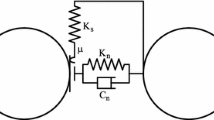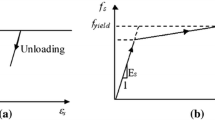Abstract
Using strain-induced orthotropic material concepts, a new numerical constitutive model is demonstrated by predicting the ultimate capacity of a unique simple test specimen and two cylindrical shell structures. Only the uniaxial compressive strength of the concrete and the yield stress of the reinforcing steel are needed as input to predict both constitutive behavior and structural strength. The approach is simple, reliable and computationally efficient.
Similar content being viewed by others
Abbreviations
- 1, 2:
-
local directions of principal strain in the concrete or the principal material directions of an orthotropic material
- a, b:
-
local directions of the steel reinforcing rods
- A i,j :
-
membrane (extensional) components of shell constitutive matrix
- B i,j :
-
membrane-bending coupling components of shell constitutive matrix
- [B]:
-
strain displacement matrix
- D i,j :
-
bending components of shell constitutive matrix
- {ΔDE}:
-
incremental global nodal displacements induced by {ΔRE}
- E c :
-
modulus of elasticity of the concrete
- E i :
-
modulus of elasticity of an orthotropic material relative to theith direction
- E ij :
-
reduced stiffness of shell constitutive matrix
- E a :
-
modulus of elasticity of the reinforcing steel taken as 200 GPa (2900 ksi)
- [E] ij :
-
tangential constitutive matrix relative to thei, j directions
- f ′ c :
-
uniaxial compressive strength of the concrete
- G ij :
-
shear modulus relative to thei,j coordinate system
- [k] i :
-
tangenital elemental stiffness matrix due to materiali (global coordinates)
- [k]:
-
tangential elemental stiffness matrix due to concrete and steel (global coordinates)
- [K]:
-
global tangential stiffness matrix
- N :
-
number of layers
- p :
-
external hydrostatic pressure
- Δp :
-
increment in load
- {re}:
-
elemental nodal load vector calculated from stress state in element
- {R}:
-
global nodal load vector of externally applied loads
- {RE}:
-
global nodal load vector calculated from the internal stresses in elements
- {ΔRE}:
-
equal to {R}—{RE}
- t k :
-
thickness of thekth shell layer
- u, v, w :
-
global displacements in the x, y, z directions
- V i :
-
elemental volume of materiali
- x, y, z :
-
global coordinate system
- z k :
-
distance from the shell midsurface to the midsurface of thekth shell layer
- ε i :
-
normal strain in theith coordinate direction
- ε ys :
-
uniaxial yield strain of the reinforcing steel
- ν:
-
effective Poisson's ratio for concrete (set equal to 0.2)
- σ i :
-
normal stress in theith coordinate direction
- σ ys :
-
uniaxial yield stress of the reinforcing steel
- {σ}:
-
vector of elemental stresses
References
Darwin, D. and Pecknold, D.A., “Analysis of RC Shear Panels Under Cyclic Loading,” J. Struct. Div., ASCE, 355–369 (1976).
Timoshenko, S.P. and Woinowsky-Krieger, S., “Theory of Plates and Shells,” 2nd Ed., McGraw-Hill Book Co., Inc. (1959).
Marti, P. and Kong, K., “Response of Reinforced Concrete Slab Elements to Torsion,” J. Struct. Eng., ASCE, 976–993 (1987).
Marti, P., Leesti, P. and Khalifa, W.U., “Torsion Tests on Reinforced Concrete Slab Elements,” J. Struct. Eng., ASCE, 994–1010 (1987).
Perdikaris, P.C. and White, R.N., “Shear Modulus of Precracked R/C Panels,” J. Struct. Div., ASCE, 270–289 (1985).
Vecchio, F.J. and Collins, M.P., “Modified Compression-Field Theory for Reinforced Concrete Elements Subjected to Shear,” J. Amer. Concrete Inst., 219–231 (1985).
Rule, W.K., “A Simple Nonlinear Constitutive Model for Finite element Investigation of Reinforced Concrete Structures,”PhD Thesis, Dept. of Eng. Mech., Univ. of Wisconsin, Madison, WI (1986).
“A State of the Art Report on Finite Element Analysis of Reinforced Concrete Structures,” ASCE Special Publication, New York (1982).
Kupfer, H., Hilsdorf, H.K. and Rusch, H., “Behavior of Concrete Under Biaxial Stresses,” J. Amer. Concrete Inst., 656–666 (1969).
“Building Code Requirements for Reinforced Concrete,” ACI 318–83, Amer. Concrete Inst. (1983).
“Guide for the Design and Construction of Fixed Offshore Structures,” J. Amer. Concrete Inst., 684–709 (1978). Revised, J. Amer. Concrete Inst., 632–639 (1984).
Timoshenko, S.P. and Goodier, J.N., “Theory of Elasticity,” 3rd Ed., McGraw-Hill Book Co., Inc. (1970).
Haynes, H.H., “Design for Implosion of Concrete Cylindrical Structures Under Hydrostatic Loading,” NTIS AD A078 641 (1979).
Haynes, H.H., “Handbook for the Design of Undersea Pressure Resistant Concrete Structures,” NTIS AD A034 200 (1976).
Zienkiewicz, O.C., “The Finite Element Method,” 3rd Ed., McGraw-Hill Book Co. (1977).
Hand, F.R., Pechnold, D.A. and Schnobrich, W.C., “Nonlinear Layered Analysis of R.C. Plates and Shells,” J. Struct. Div., ASCE, 355–369 (1976).
Ghoneim, G.A.M. andGhali, A., “Nonlinear Analysis of Concrete Structures,”Canadian J. Civil Eng.,9,489–501 (1982).
Jones, R.M., “Mechanics of Composite Materials,” Scripta Book Co. (1975).
Chen, A.C.T. and Chen, W.F., “Constitutive Relations for Concrete,” J. Eng. Mech. Div., ASCE, 465–481 (1975).
Chen, W.F., Suzuki, H. and Chang, T.Y., “Nonlinear Analysis of Cylinder Structures Under Hydrostatic Loading,” Comp. and Struct., 559–570 (1980).
Chen, W.F., Suzuki, H. and Chang, T.Y., “End Effects of Pressure Resistant Concrete Shells,” J. Struct. Div., ASCE, 751–771 (1980).
Hughes, B.P. andChapman, G.P., “The Complete Stress-Strain Curve for Concrete in Direct Tension,”RILEM Bul. 30, 95–97 (1966).
Ahmad, S., “Properties of Confined Concrete Under Static and Dynamic Loads,” PhD Diss., Univ. of Illinois at Chicago Circle, Dept. of Mat. Eng. (1981).
Author information
Authors and Affiliations
Rights and permissions
About this article
Cite this article
Rule, W.K., Rowlands, R.E. A simple orthotropic elasticity-based constitutive model for reinforced concrete. Experimental Mechanics 29, 448–454 (1989). https://doi.org/10.1007/BF02323866
Received:
Revised:
Issue Date:
DOI: https://doi.org/10.1007/BF02323866




